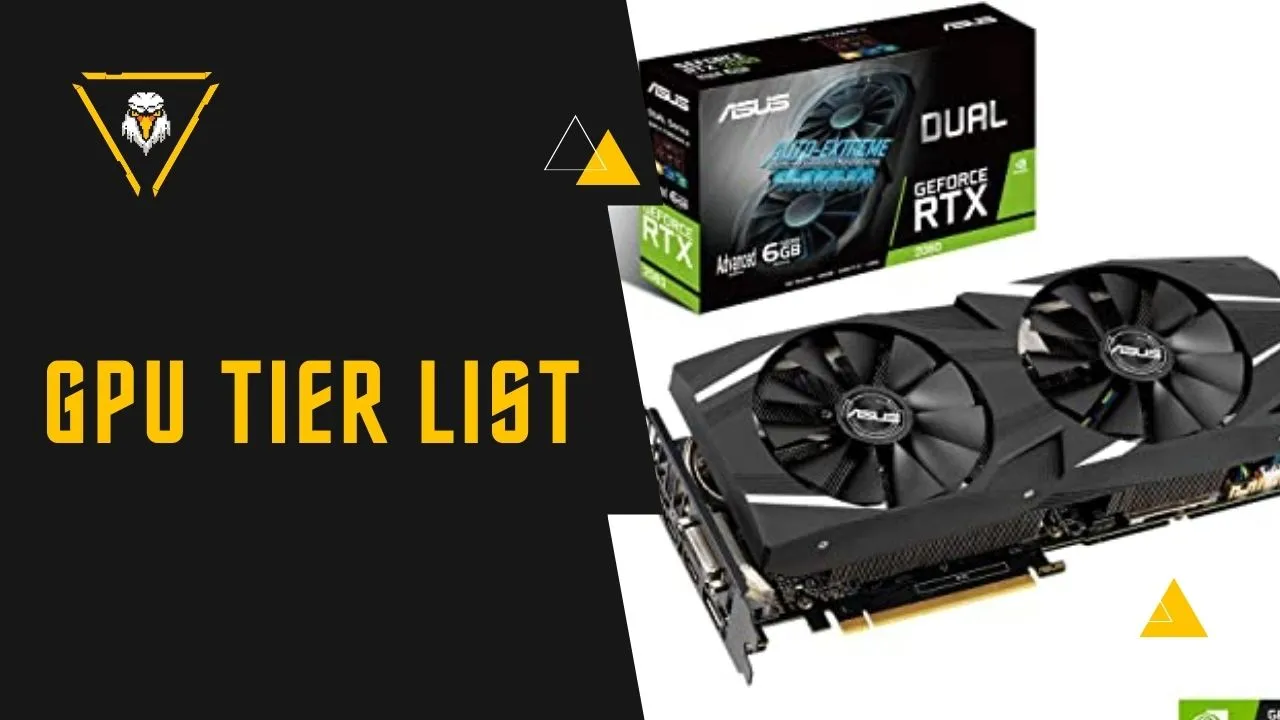The GPU tier list benchmarks 2021 is an informative article designed to help PC gamers make informed decisions about their graphics cards. This post will give information on what the most powerful graphics cards are, how they compare to each other, and also show some of the new graphics card releases.
There are many different types of GPUs available, which can be confusing when it comes time to purchase a new one. Best Graphics cards are one the most important parts of upgrading your computer. Choosing an excellent functional GPU can be tough, especially if there is an extensive list to choose from! In 2021 you will find zillions of graphics card options: Nvidia and AMD both have their own line up with many different models, each vying for superiority in 4k rendering or gaming enhancement.
A Foretaste to the Hierarchy
The following is a list of the best gaming graphics cards for gamers. These are based on performance and fps rates, so if you’re looking to buy one now, then this should be just perfect!
The rankings were recorded in official records from different sources such as benchmarks websites or other publications that track such information over time. We assure you these results go with what’s being said at first glance; without further ado, let us post-mortem its performance data via making a chart.
GPU Tier List – Graphics Card Comparison List – GPU Hierarchy
Tier Level S Platinum
| Brand Name | Rating | Base | GPU | VRAM | Power | Bus Width |
| Nvidia Titan RTX | 10/10 | 1350/1770 MHz | TU102 | 24 GB DDR6 | 280 Watts | 384-bit |
| Nvidia GeForce RTX 2080 Ti | 9.68/10 | 1350/1635 MHz | TU102 | 11GB GDDR6 | 260 Watts | 352-bit |
| Nvidia GeForce RTX 2080 Super | 8.51/10 | 1650/1815 MHz | TU104 | 8GB GDDR6 | 250 Watts | 256-bit |
| Nvidia GeForce Titan V | 8.50/10 | 1200/1455 MHz | GV100-400-A1 | 12GB HBM2 | 600 watts | 3072-bit |
| Nvidia GeForce RTX 2080 | 8.0/10 | 1515/1800 MHz | TU104 | 8GB GDDR6 | 225 Watts | 256-bit |
| Nvidia GeForce Titan Xp | 7.99/10 | 1418/1582 MHz | GP102-450-A1 | 12GB GDDR5X | 600 watts | 384-bit |
Tier Level A High
| Name | Rating | Boast | GPU | VRAM | Power | Bus width |
| Nvidia GeForce RTX 2070 Super | 7.58/10 | 1605/1770 MHz | TU104 | 8GB GDDR6 | 215 watts | 256-bit |
| AMD Radeon VII | 7.51/10 | 1400/1750 MHz | Vega 20 | 16Gb HBM2 | 250 watts | 4096-bit |
| Nvidia Titan X | 7.48/10 | 1405/1480 MHz | GP102 | 12GB GDDR5X | 250 watts | 384-bit |
| AMD Radeon RX 5700 XT | 7.47/10 | 1605/1905 MHz | Navi 10 | 8GB GDDR6 | 225 watts | 256-bit |
| Nvidia RTX 2060 Super | 7.45/10 | 1470/1650 MHz | TU106 | 8GB GDDR6 | 175 watts | 256-bit |
| Nvidia RTX 2070 | 7.43/10 | 1410/1710 MHz | TU106 | 8GB GDDR6 | 185 watts | 256-bit |
| Nvidia GeForce GTX 1080 Ti | 7.42/10 | 1480/1582 MHz | GP102 | 11GB GDDR5X | 250 watts | 256-bit |
Tier Level B High Mid-Range
| Name | Rating | Base | GPU | VRAM | Power | Bus Width |
| AMD Radeon RX 5700 | 6.55/10 | 1565/1725 MHz | Navi 10 | 8GB GDDR6 | 185 watts | 256-bit |
| AMD Radeon RX Vega 64 | 6.22/10 | 1274/1546 MHz | Vega 10 | 8GB HBM2 | 295 watts | 2048-bit |
| Nvidia GeForce GTX 1080 | 6.13/10 | 1607/1733 MHz | GP104 | 8GB GDDR6 | 180 watts | 256-bit |
| Nvidia GeForce RTX 2060 | 5.72/10 | 1365/1680 MHz | TU106 | 6GB GDDR6 | 160 watts | 192-bit |
| AMD Radeon RX Vega 56 | 5.49/10 | 1156/1471 MHz | Vega 10 | 8GB HBM2 | 210 watts | 2048-bit |
| Nvidia GeForce 1070 Ti | 5.38/10 | 1607/1683 MHz | GP104 | 8GB GDDR5 | 180 watts | 256-bit |
| Nvidia GeForce GTX 1660 Ti | 4.86/10 | 1365/1680 | TU116 | 6GB GDDR6 | 120 watts | 192-bit |
Tier Level C Mid Range
| Name | Rating | Base | GPU | VRAM | Power | Bus Width |
| AMD Radeon R9 Fury X | 4.20/10 | 1050 MHz | Fiji | 4GB HBM | 275 watts | 4096-bit |
| AMD Radeon RX 590 | 4.16/10 | 1369/1545 MHz | Polaris 30 | 8GB GDDR5 | 225 watts | 256-bit |
| AMD Radeon RX 5500 XT | 4.05/10 | 1607/1717 MHz | Navi 14 | 8GB GDDR6 | 130 watts | 128-bit |
| AMD Radeon RX 580 | 3.82/10 | 1257/1340 MHz | Polaris 20 | 8GB GDDR5 | 185 watts | 256-bit |
| Nvidia GeForce GTX 1650 Super | 3.66/10 | 1530/1725 MHz | TU116 | 4GB GDDR6 | 100 watts | 128-bit |
| AMD Radeon R9 390 | 3.49/10 | 1000 MHz | Hawaii | 8GB GDDR5 | 275 watts | 512-bit |
| Nvidia GeForce GTX 1060 | 3.40/10 | 1506/1708 MHz | GP106 | 6GB GDDR5 | 165 watts | 192-bit |
Tier Level D Mid-Low Range
| Name | Rating | Base | GPU | VRAM | Power | Bus Width |
| Nvidia GTX 980 | 3.40/10 | 1126/1216 MHz | GM204 | 4GB GDDR5 | 165 watts | 256-bit |
| AMD Radeon RX 570 | 3.24/10 | 1168/1244 MHz | Polaris 20 | 4GB GDDR5 | 150 watts | 256-bit |
| Nvidia GeForce 1050 Ti | 2.06/10 | 1385/1665 MHz | TU117 | 4GB GDDR5 | 75 watts | 128-bit |
| AMD Radeon RX 560 | 1.61/10 | 1175/1275 MHz | Polaris 21 | 4GB GDDR5 | 80 watts | 128-bit |
| Nvidia GeForce 1050 | 1.57/10 | 1354/1455 MHz | GP107 | 2GB GDDR5 | 75 watts | 128-bit |
| AMD Radeon RX 550 | 1.0/10 | 1100/1183 MHz | Polaris 22 | 4GB GDDR5 | 50 watts | 128-bit |
| Nvidia GeForce GT 1030 | 0.72/10 | 1228/1462 MHz | GP108 | 2GB GDDR5 | 30 watts | 64-bit |
The Gem Graphics cards
The top tier of GPUs is the Platinum Collection (S). These cards have all sorts of advanced technology and are only available to high-end gamers, billionaires, or those with deep pockets.
That’s because they provide features that no other card does – like RTX Technology from Nvidia, which brings true gaming immersion into reality by using super-fast graphics rendering processes on your screen, so you feel like time has almost stopped while playing games such VRAM allows users access up to 12 GB.
Vanity Graphics cards
Tier A GPUs are the same as Platinum Tiers because of their similar performance stats. The reason for not being above Tier 1 is nothing but a few ups and downs in FPS and cost range.
This can make these cards somewhat affordable if you have a vision for setting up an awesome rig like that! Surprisingly Nvidia still leads the second tier when it comes to 4K/ 1440P gaming with the newest technology implemented into RTX card–and here witnessed AMD coming back into role play by taking two spots.
Unparalleled Performance Graphics cards
Gosh, Tier B is the best! It has cards that can produce unparalleled performance and are easy to buy. The balance between price tag and what they offer makes them perfect for enthusiasts who want premium quality without breaking their bank accounts or not being able to find a card in stores nearby (plus, these ones don’t need much power).
But there’s one problem -these high-end graphics cards only provide an Ultra HD gaming experience which means 4K games won’t run properly. So unless you have monitors capable of enough refresh rates so basically, if your computer doesn’t meet those requirements, then this tier isn’t a good choice.
Conclusion:
To get the most out of your system, you need a graphics card that has been tailored just for gaming. The best cards will fit into one tier as determined by three different qualities: price-performance ratio (PPR), thermal output, and power consumption levels!
These tiers can vary depending on what’s most important to each individual gamer or editor in terms of features. They aren’t meant to degrade potential gamers with less money but rather offer guidance about which product would suit their needs best.
While meeting those particular criteria – so take it accordingly when deciding between A-D+ models above. If affordability matters, then go ahead and pick whichever option. HAPPY GAMING!
Also See:

